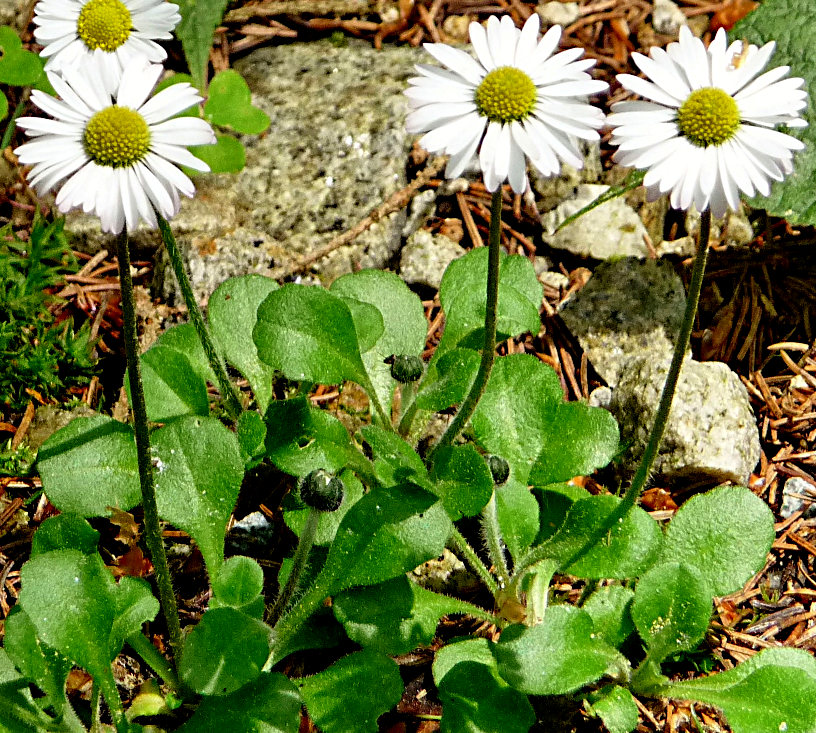Wise Mind Herbs
Evidence-based Herbal Healing
The information on this page has been prepared with reference to published scientific literature, not by a medically qualified expert. It is not medical advice. Any decision to use a supplement or herb-based product is your responsibility. Consult a suitably qualified medical professional, especially if you have underlying conditions. Remember, nothing is for everyone, and not everything sold is what it claims to be. Some things work for some people, some of the time.
Daisy - Bellis perennis
Daisies belonging to the genus Bellis, particularly Bellis perennis (common daisy, English daisy, or lawn daisy), have a long history of traditional medicinal use. This review examines the current scientific understanding of their therapeutic properties based on peer-reviewed literature.

Image source and license: https://commons.wikimedia.org/wiki/File:Bellis_perennis_-_G%C3%A4nsebl%C3%BCmchen_Spiegelh%C3%BCtte.jpg.
Modified by Peter Jorgensen.
Botanical Classification and Common Names
Bellis perennis is the most studied species within the Bellis genus. It's important to note that many plants with "daisy" in their common name belong to different genera and have different properties. Plants commonly confused with Bellis perennis include:
- Oxeye daisy (Leucanthemum vulgare, formerly Chrysanthemum leucanthemum)
- Shasta daisy (Leucanthemum × superbum)
- Chamomile (Matricaria chamomilla or Chamaemelum nobile), sometimes called "German daisy"
- Marguerite daisy (Argyranthemum frutescens)
- Gerbera daisy (Gerbera jamesonii)
Active Compounds
Bellis perennis contains several bioactive compounds, including saponins (particularly bellissaponins), flavonoids, essential oils, phenolic acids, polyacetylenes, and triterpenoids. These compounds contribute to its reported biological activities.
Evidence-Based Therapeutic Applications
It should be noted that compared to many medicinal plants, the scientific evidence for Bellis perennis is limited, with most studies being in vitro or animal models rather than robust clinical trials.
- Anti-inflammatory properties: Several studies have demonstrated anti-inflammatory effects of Bellis perennis extracts, potentially useful for conditions like arthritis and skin inflammation.
- Wound healing: Preliminary studies suggest potential benefits for tissue repair and wound healing.
- Antioxidant activity: Extracts have shown free radical scavenging properties in laboratory studies.
- Antimicrobial effects: Some research indicates antimicrobial activity against certain bacterial strains.
- Hepatoprotective effects: Limited animal studies suggest potential liver-protective properties.
Despite traditional claims, there is insufficient clinical evidence to support that Bellis perennis "cures" any specific condition. Most applications remain investigational or complementary.
Dosage Recommendations
Due to limited clinical trials, standardized dosing guidelines for Bellis perennis are not well established. The literature suggests:
- Topical preparations: Creams or ointments containing 2-5% Bellis perennis extract have been used in limited studies for skin conditions.
- Oral preparations: Traditional dosages range from 1-4g of dried herb daily, often as tea (infusion).
- Tincture: 2-4mL of 1:5 tincture, typically taken three times daily.
Importantly, these dosages are based primarily on traditional use rather than clinical evidence. Commercial preparations lack standardization regarding specific active compounds like saponins or flavonoids.
Safety Profile and Side Effects
Bellis perennis is generally regarded as having low toxicity, but safety data from systematic clinical studies are limited.
- Allergic reactions: Individuals with allergies to plants in the Asteraceae family may experience allergic reactions.
- Dermatitis: Contact dermatitis has been reported in sensitive individuals.
- Pregnancy and lactation: Insufficient safety data; traditionally avoided during pregnancy.
- Drug interactions: Limited research on potential interactions with medications.
No studies specifically examining high-dose toxicity or establishing a maximum tolerated dose were identified in the current literature, representing a significant knowledge gap. The therapeutic window and dose-response relationship remain poorly characterized.
Pharmaceutical Products
Unlike herbs such as St. John's wort or ginkgo biloba, Bellis perennis has not been developed into standardized pharmaceutical products with regulatory approval for specific medical indications. It is primarily available in:
- Homeopathic preparations (Bellis perennis is used in various homeopathic remedies)
- Traditional herbal supplements (often in combination products)
- Topical cosmetic formulations for skin care
No FDA-approved or EMA-approved pharmaceutical drugs containing Bellis perennis extract or derivatives were identified in the current literature.
Research Gaps and Future Directions
Significant knowledge gaps exist regarding Bellis perennis medicinal applications:
- Lack of randomized controlled trials in humans
- Insufficient standardization of extracts and active compounds
- Limited pharmacokinetic and pharmacodynamic data
- Absence of dose-finding studies and maximum tolerated dose investigations
- Inadequate long-term safety evaluations
Future research should focus on standardized extracts, identification of key active compounds, and properly designed clinical trials to establish efficacy and optimal dosing.
References
Albien, A. L., & Stark, T. D. (2023). (Bio) active Compounds in Daisy Flower (Bellis perennis). Molecules, 28(23), 7716.
Al-Snafi, A. E. (2015). Therapeutic properties of medicinal plants: a review of medicinal plants with central nervous effects (part 1). Int J of Pharmacology & Toxicology, 5(3), 177-192.
Ceylan, O., Ugur, A., & Sarac, N. (2014). In vitro antimicrobial, antioxidant, antibiofilm and quorum sensing inhibitory activities of Bellis perennis L. Journal of BioScience & Biotechnology.
Karakas, F. P., Karakas, A., Coşkun, H., & Turker, A. U. (2011). Effects of common daisy (Bellis perennis L.) aqueous extracts on anxiety-like behaviour and spatial memory performance in Wistar albino rats. Afr. J. Pharm. Pharmacol, 5, 1378-1388.
Karakas, F. P., Turker, A. U., Karakas, A., Mshvildadze, V., Pichette, A., & Legault, J. (2017). In vitro cytotoxic, antibacterial, anti-inflammatory and antioxidant activities and phenolic content in wild-grown flowers of common daisy—A medicinal plant. Journal of herbal medicine, 8, 31-39.
Siatka, T., & Kašparová, M. (2010). Seasonal variation in total phenolic and flavonoid contents and DPPH scavenging activity of Bellis perennis L. flowers. Molecules, 15(12), 9450-9461.